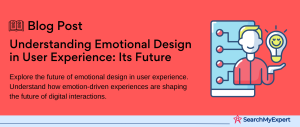UX Research Methods
User Experience (UX) research is a crucial process in understanding the behaviors, needs, and motivations of users when interacting with products and services. It plays a fundamental role in designing solutions that are both effective and enjoyable to use. Let’s explore the key aspects of UX research:
Defining User Experience and the Role of Research Within It:
- UX refers to the overall experience a person has when interacting with a digital product or service, like a website, application, or software.
- The role of UX research is to gather insights about users—what they need, what they value, their abilities, and their limitations.
- It involves studying user behavior and attitudes through various research methodologies to improve product design and functionality.
Why is UX Research Essential? Highlighting the Benefits of User-Centered Design:
- UX research is essential because it ensures that the product design is aligned with the user’s needs and expectations.
- It helps in identifying problems early, which can save time and resources in the development process.
- By focusing on the user, companies can increase customer satisfaction and loyalty, ultimately leading to better business outcomes.
Types of UX Research: Exploring Quantitative and Qualitative Methodologies:
- Quantitative Research:
This involves collecting and analyzing numerical data. It’s used for measuring user behavior, such as how many times a feature is used, or conducting surveys with large sample sizes for statistical analysis. - Qualitative Research: This is more about understanding the user’s thoughts and feelings. Methods include user interviews, usability testing, and observation. This type of research provides deeper insights into the user’s experiences and motivations.
Choosing the Right Method
Choosing the right method for UX research is a critical step that requires careful consideration of research goals, project constraints, and ethical standards. Let’s delve into how to navigate this decision-making process:
Matching Research Goals to Methods:
- The first step is to define what you need to learn about your users. Is it about their behavior, attitudes, preferences, or usability issues?
- Quantitative methods like surveys and analytics are best suited for answering ‘what’ and ‘how many’ questions, providing statistical insights.
- Qualitative methods like interviews, focus groups, and usability tests are ideal for understanding ‘why’ and ‘how’—delving into user motivations, thoughts, and experiences.
- Sometimes, a mixed-method approach is beneficial, combining both quantitative and qualitative data for a more comprehensive understanding.
Considering Project Constraints:
- Budget: Some methods are more cost-intensive (e.g., in-depth interviews may require incentives for participants). Consider lower-cost alternatives like online surveys or usability tests with fewer participants.
- Timeline:
Some methods take longer than others. For instance, surveys can be quicker to execute compared to long-term ethnographic studies. - Target Audience: Accessibility of your target audience is crucial. For hard-to-reach demographics, methods like remote interviews or online usability testing can be effective.
Ethical Considerations in UX Research:
- Respectful Data Collection:
Ensure that participation in research is voluntary and that participants are fully informed about the purpose of the research and how their data will be used. - Privacy and Confidentiality: Adhere to data protection laws and regulations. Anonymize data where possible and secure personal information.
- Responsible Analysis: Interpret data objectively and responsibly. Avoid biases and ensure that findings are representative of the user group, not just a subset.
Quantitative Methods
In UX research, quantitative methods are invaluable for objectively measuring user behavior, preferences, and experiences. These methods provide statistical data that can inform design decisions and improve user interfaces. Let’s explore some key quantitative methods used in UX research:
Surveys and Questionnaires:
- These tools are used to gather information about user demographics, attitudes, opinions, and satisfaction.
- They can be distributed widely, allowing researchers to collect data from a large sample size, which enhances the statistical significance of the results.
- Surveys and questionnaires can be conducted online, via email, or in-person, and can include a variety of question types such as multiple-choice, Likert scales, and open-ended questions.
Analytics and A/B Testing:
- Analytics:
This involves using tools to track and analyze how users interact with a website or app. Metrics like page views, time spent on the site, and user flow can reveal a lot about user behavior and preferences. - A/B Testing: This is a method of comparing two versions of a webpage or app against each other to determine which one performs better. It’s a powerful way to make data-driven decisions about design changes.
Eye Tracking and Heatmaps:
- Eye Tracking: This method involves tracking where and how long a user looks at different areas of a webpage or app interface. It provides insights into what attracts users’ attention and what they might be ignoring.
- Heatmaps:
These are visual representations of data where values are represented by colors. In UX, heatmaps can show where users are clicking, how far they are scrolling, and what parts of a page are getting the most attention.
Qualitative Methods
Qualitative methods in UX research provide a deeper, more nuanced understanding of user needs, motivations, and behaviors. These methods are essential for uncovering insights that quantitative data alone cannot provide. Let’s explore some of the key qualitative methods used in UX research:
Interviews and Focus Groups:
- Interviews:
These are one-on-one sessions where researchers ask participants detailed questions about their experiences, feelings, opinions, and preferences. Interviews can uncover rich, in-depth insights into user needs and challenges. - Focus Groups:
These involve a group of participants discussing a product or service. Moderated by a researcher, focus groups can generate a diverse range of opinions and stimulate discussions that reveal collective viewpoints and shared experiences.
Usability Testing and Card Sorting:
- Usability Testing: This method involves observing users as they interact with a product to identify usability issues and areas for improvement. It provides direct insight into how real users use (or struggle to use) a product and why.
- Card Sorting:
This is a technique used to help design or evaluate the information architecture of a site. Participants organize topics into categories that make sense to them, which helps in understanding user thought processes and preferences.
User Personas and Empathy Mapping:
- User Personas: These are fictional characters created to represent different user types that might use a service, product, site, or brand. Personas help in understanding the users’ goals, desires, and limitations and serve as a reference point for design decisions.
- Empathy Mapping:
This tool helps designers empathize with users. It involves creating a visual map that articulates what users say, think, do, and feel. It’s a useful technique in understanding the user’s emotional and psychological experiences.
Data Collection and Analysis
Effective data collection and analysis are pivotal stages in UX research, transforming raw data into actionable insights. This process involves meticulous planning, careful organization, and clear communication of findings. Let’s delve into these aspects:
Planning Effective Data Collection:
- Selecting Tools and Techniques:
Choose tools and techniques that align with your research objectives. For quantitative data, you might use surveys, web analytics, or A/B testing tools. For qualitative data, interviews, focus groups, or usability testing tools are appropriate. - Defining Parameters:
Clearly define what data you need to collect to answer your research questions. This includes deciding on sample sizes, demographics, and the metrics or types of responses you want to capture. - Ensuring Reliability: Implement strategies to ensure the reliability of your data. This might include pilot testing your tools, training researchers or moderators, and ensuring your sample is representative of your user base.
Organizing and Analyzing Data:
- Data Organization:
Once collected, organize your data systematically. For quantitative data, this might involve statistical software or spreadsheets. For qualitative data, it could involve transcribing interviews or categorizing responses. - Analysis Methods:
Quantitative data analysis often involves statistical methods to identify patterns or trends. Qualitative analysis might include thematic analysis, where responses are categorized into themes, or content analysis for more detailed interpretation. - Combining Data Types: If using mixed methods, consider how to integrate qualitative and quantitative findings for a comprehensive understanding.
Reporting and Presenting Findings:
- Tailoring Reports for Stakeholders: Create reports that are understandable and relevant to your audience, whether they are designers, product managers, or executives. Highlight key findings and recommendations in a clear, concise manner.
- Visualizing Data:
Use graphs, charts, and infographics to make quantitative data more accessible. For qualitative data, quotes or narratives can bring user stories to life. - Actionable Insights: Focus on providing actionable insights. It’s not just about what the data says, but what should be done as a result. Recommendations should be practical and aligned with the project’s goals.
Applying Insights to Design
Applying insights gained from UX research to design is a critical step in ensuring that products meet the needs and expectations of users. This process involves iterating designs based on research findings, validating these designs through prototyping and testing, and measuring the overall impact of UX research on the project’s success. Let’s break down these steps:
Iterating and Improving Designs Based on User Research Findings:
- Incorporating Feedback: Start by integrating the insights gained from your research into the design. This could involve modifying features, improving usability, or changing the visual design based on user preferences.
- Iterative Design Process: Design should be seen as an iterative process. After integrating feedback, further rounds of testing and feedback may be necessary. This iterative cycle helps in refining the product to better meet user needs.
- Collaboration: Ensure there is a collaborative effort between designers, researchers, and other stakeholders. Regular meetings and discussions can help in aligning the design with the research findings and business goals.
Prototyping and Validating Designs for User Acceptance:
- Develop Prototypes:
Create prototypes of your design – these can range from low-fidelity sketches to high-fidelity interactive models. Prototypes are essential for testing design concepts without fully developing the product. - User Testing: Conduct user tests with these prototypes to validate the design decisions. Observe how users interact with the prototype and gather feedback on what works well and what needs improvement.
- Iterate Based on Feedback: Use the feedback from testing to make further refinements. This process helps in validating that the design meets user requirements before full-scale development.
Measuring the Impact of UX Research on Project Success:
- Defining Success Metrics:
Establish clear metrics for measuring the success of the design. This could include user satisfaction scores, usability metrics, conversion rates, or other relevant KPIs. - Comparing Pre and Post-Research Metrics: To measure the impact of UX research, compare these metrics before and after applying research insights. Improvements in these metrics can demonstrate the value of the research.
- Documenting Changes and Outcomes:
Keep a record of the changes made based on UX research and the outcomes of these changes. This documentation can be valuable for understanding the effectiveness of UX research in the project and for informing future projects.
Best Practices and Resources
To conduct effective UX research and continually enhance skills in this field, it’s important to follow best practices and stay engaged with a range of resources. Here are some tips and resource recommendations:
Best Practices in Conducting UX Research
- Use a Combination of Methods: Employ both qualitative and quantitative methods to get a comprehensive understanding of user behavior and preferences.
- Stay User-Centered: Always keep the focus on the users. Understand their needs, challenges, and motivations deeply.
- Iterative Approach: Treat UX research as an ongoing process. Continually test, learn, and improve.
- Collaboration is Key:
Work closely with designers, developers, and other stakeholders. Share insights and integrate feedback throughout the design process. - Ethical Considerations: Always prioritize the privacy and comfort of your research participants. Obtain consent, ensure anonymity, and be transparent about how data will be used.
- Leverage the Right Tools: Utilize various tools for surveys (like SurveyMonkey), analytics (like Google Analytics), usability testing (like UserTesting), and prototyping (like Sketch or Figma).
- Stay Organized: Keep your data and findings well-organized for easy analysis and reference. Use tools like spreadsheets, databases, or qualitative data analysis software.
Additional Resources for Learning More
Books:
- “The Design of Everyday Things” by Don Norman:
A foundational book on design thinking and user-centered design. - “Don’t Make Me Think” by Steve Krug:
A classic on web usability, offering practical advice on designing intuitive and effective digital interfaces. - “Lean UX” by Jeff Gothelf and Josh Seiden: Focuses on applying lean principles to improve user experience.
Online Articles and Blogs:
- Nielsen Norman Group Articles:
Provides in-depth articles on various UX topics. - UX Magazine: Offers articles and insights from UX professionals.
- Smashing Magazine’s UX Design Section:
Covers the latest trends and best practices in UX design.
Online Communities and Forums:
- UX Stack Exchange: A Q&A community for UX researchers and designers.
- LinkedIn Groups: Join groups like UX Researchers, UX Designers, or Interaction Design Association for discussions and networking.
- Slack Communities:
Platforms like Designer Hangout and UX Guide offer spaces for real-time discussions and networking.
Online Courses and Webinars:
- Coursera and Udemy offer various courses on UX/UI design, taught by industry experts.
- Attend webinars hosted by UX professionals. Sites like UXPA (User Experience Professionals Association) often list upcoming events.
Conferences and Workshops:
- Attend UX conferences like UXSTRAT, UX Week, or Nielsen Norman Group’s Usability Week for the latest insights and networking opportunities.
Conclusion:
Mastering UX research is about more than just understanding users; it’s about integrating this understanding into every aspect of the design process. From defining what UX research is, to selecting the right methods, collecting and analyzing data, and finally applying these insights to design, each step is crucial in creating products that resonate with users.
Adhering to best practices, considering ethical implications, and staying informed through a variety of resources is key to evolving as a UX researcher. Whether you’re a beginner or an experienced practitioner, continuous learning and adaptation are essential in the dynamic field of UX research. By prioritizing user needs and staying committed to user-centered design principles, we can create digital experiences that are not only functional but also deeply engaging and satisfying.
Partner for success with top-tier UX Design Agencies.
Table of Contents
Toggle






